Adamley hand-screen printing, Macclesfield
Let me set the scene. Macclesfield is a small English market town, and it’s a grey day. The bright-green casentino overcoat of Benedikt Fries, as he walks towards us, rather stands out.
Photographer Alex Natt and I are watching him approach from outside the train station. It's raised up above the town centre, and he is a bright green dot in the middle of the high street.
The three of us are there to see Adamley, the silk printers. Benedikt comes here regularly to place orders for his brand, Shibumi, and I’ve been wanting to visit for a while. So we have combined.
Benedikt always talked about how much he liked visiting Adamley, describing it as an idyllic slice of England. On this grey morning, I’m slightly worried his view of England might be a little skewed (he is German).
But as we get in a taxi and ride out of town, the weather starts to brighten up. We roll into some bright, lush countryside, and after 10 minutes pull into a country lane.
There is a babbling brook, with sun glinting off it, and a dry-stone wall. Adamley is at the bottom of the lane, with a green field rising behind. There are sheep and horses in the field. I begin to see what Benedikt means.
Adamley is one of few hand-screen printers left in the country - the other well-known one being Robert Keyte, just up the road.
They don’t make woven silks, but were at one stage part of the same company as Vanners, which along with Stephen Walters is one of the best-known silk weavers. (Vanners was one of the first factories I ever visited for Permanent Style - back in 2009.)
Adamley has a large archive, a lot of which comes from the old company David Evans (Vanners has the woven side of that collection), and it’s the archive that often first attracts designers such as Benedikt.
The David Evans part dates from the 1930s, 50s and 60s, but there are also smaller collections (English and French) that date back to the 1890s.
When Benedikt started Shibumi, a lot of the designs were re-workings or re-colourings of these archive pieces.
Today, though, pretty much everything at Shibumi is original and designed in Florence (such as the maps series - one shown below). Benedikt comes up with a concept, and an in-house designer turns that into a digital image to send to Adamley.
The piece above is being digitally printed, but most of Adamley’s work is screen printing (around 80%).
Digital printing is generally used when a design requires a larger number of colours, or particularly fine detail. And when the material is too fine or large to fit the screens.
The advantages of screen printing are richness of colour, and penetration of the fabric - you can spot a digitally printed tie because the back will be white.
When we saw the screen printing, it was hard not to reflect on how different Adamley was from Hermes, which I visited in Lyon earlier in the year.
At Adamley, the printing screens are cleaned by a large man in large boots, using a large hose. At Hermes it’s done by a 10-foot-tall mechanical arm.
At Adamley, the room for mixing colours looks like something out of Willy Wonka. Every implement and surface has a different splatter pattern across it. At Hermes, sparkling white lab coats were worn.
And at Adamley, the dyes are spread onto each silk piece by hand, and applied with a stick. Even Benedikt had a go. Hermes is automated.
The technical sophistication of Hermes has real advantages. As I reported back in March, there can be up to 48 different screen prints (it’s one per colour) on an Hermes piece, with the average in the 30s. Adamley usually does 5-8, and once did 18 (“never again”).
The scale of the Hermes production is also the only way they can still screen-print everything (in France) and yet still sell to hundreds of shops.
But it’s hard to deny that Adamley has more character.
Every bucket has a mini-Pollock dashed across it, and the cumulative effect is highly stimulating. It makes you want to roll your sleeves up and start mixing and painting yourself.
The screen archive in the roof, however, might be my favourite space.
Here, all the engraved screens of all the customers are stacked in rows under the eaves. It’s quiet, and dim, with all the brightness coming from those canvas-sized screens.
Each almost looks like a work of art in itself, with its brightly coloured tape and edges. Perhaps a Rothko to the bucket's Pollock.
Benedikt and I have a long conversation about whether one of them might look nice hanging on the wall. And how feasible it would be to ship it to Florence.
As with my recent article on the Horween tannery, the point of this piece is largely to give you a sense for what Adamley is like.
So that when you see a silk handkerchief from Shibumi, or Drake’s, or any other Adamley client, you feel a little of the creative process that went into its manufacture.
Hopefully these photos and descriptions have done a little bit of that.
Photography: Alex Natt
Benedikt is wearing Shibumi, tailoring, shirts and accessories
I am wearing:
- Green nubuck jacket from Sartoria Melina
- Grey flannels from Anderson & Sheppard
- Lighter Everyday Denim shirt from Permanent Style
- Cashmere Arran scarf from Begg
- Suede unlined Dover shoes from Edward Green
- 'Marc' coat from Coherence, via the Armoury


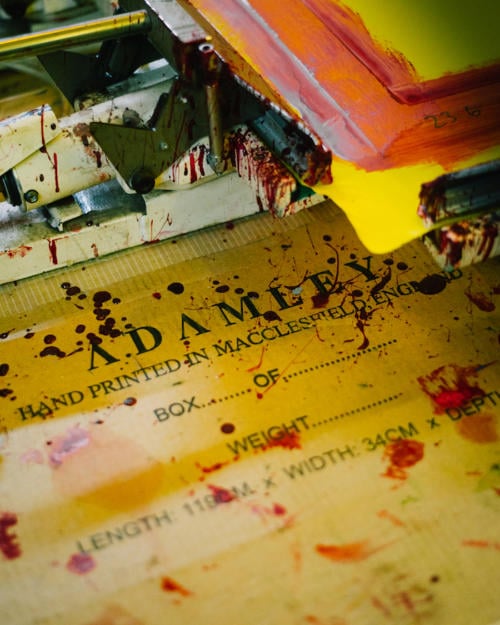
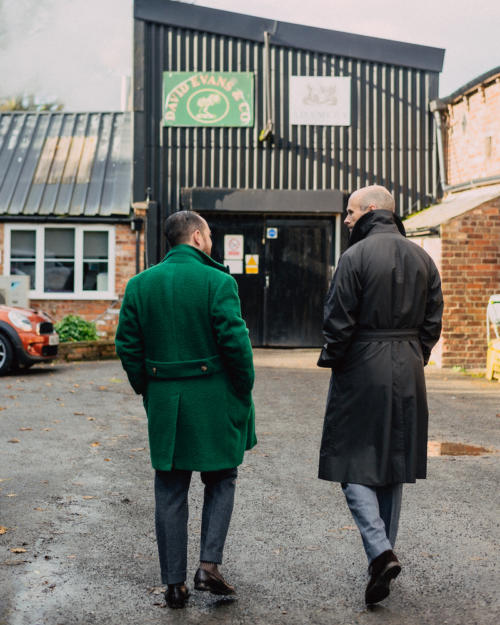
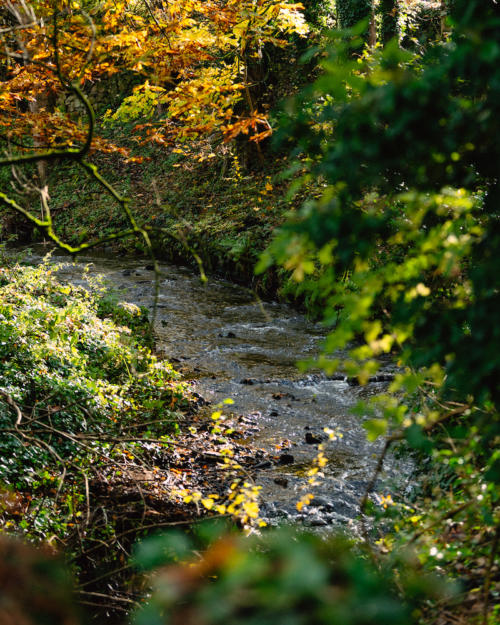
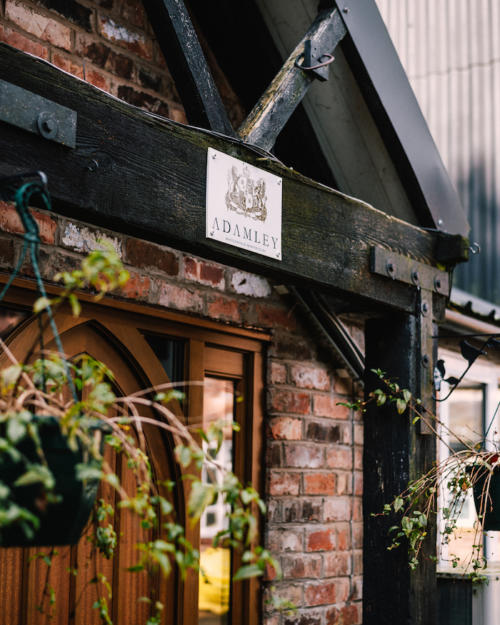
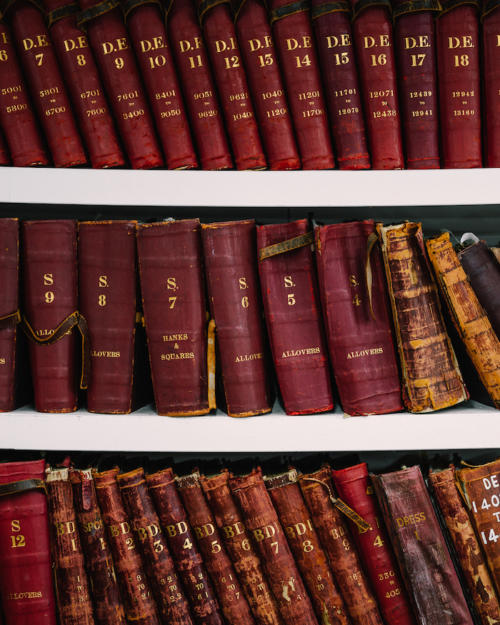
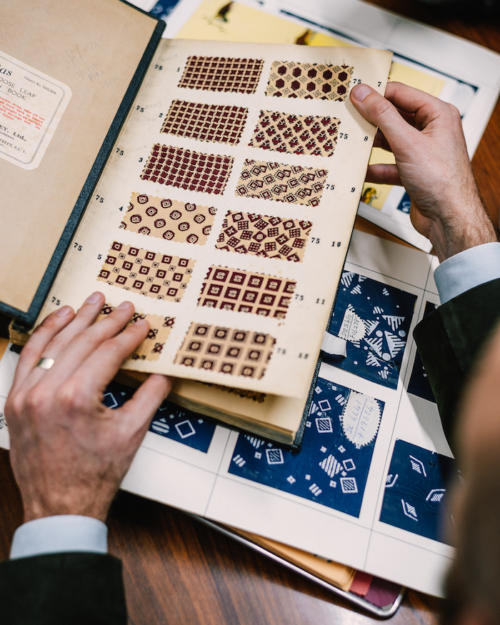
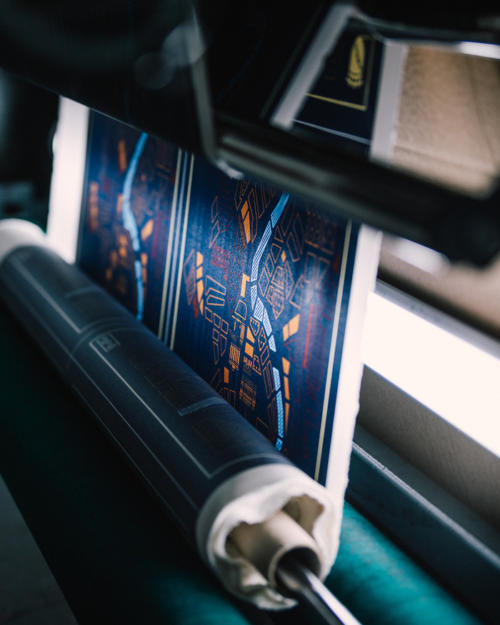
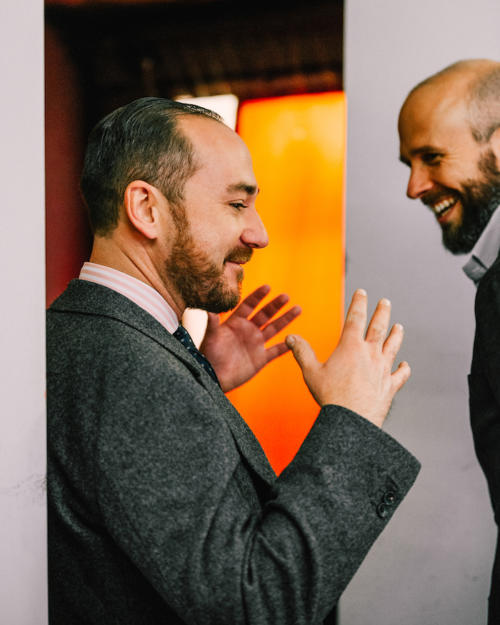
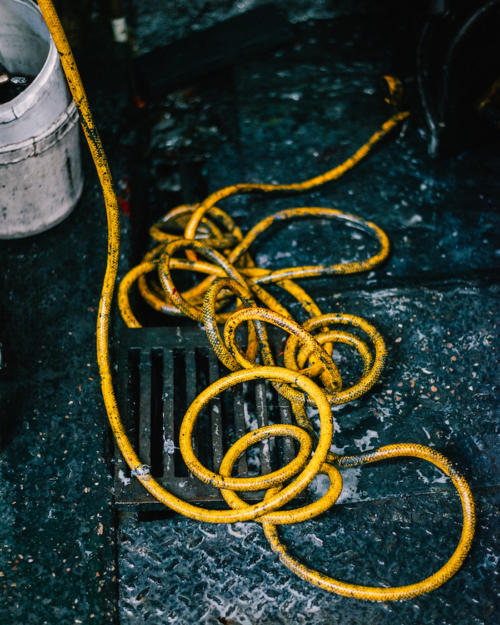
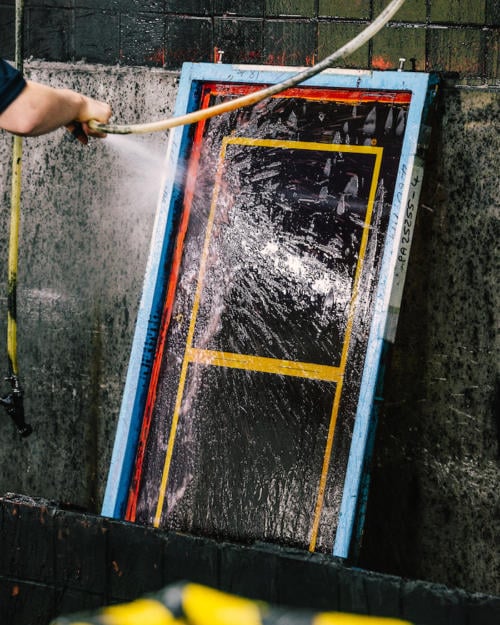
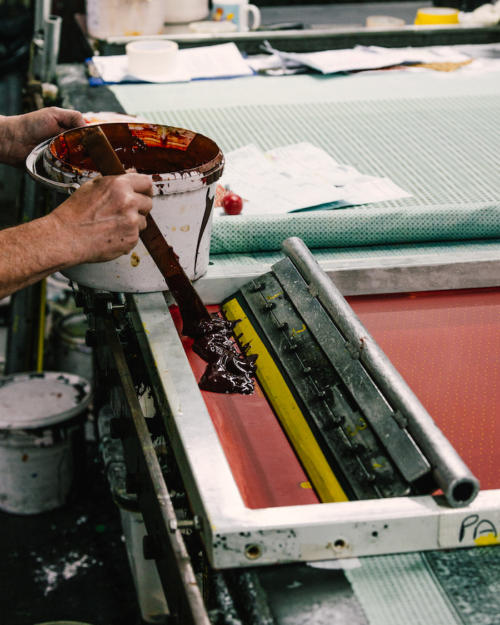
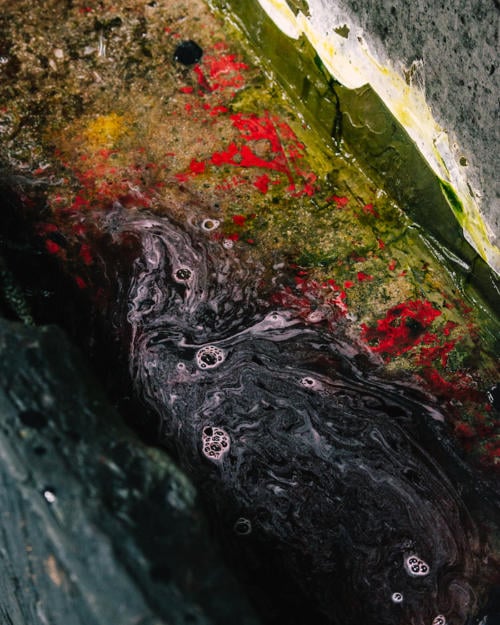
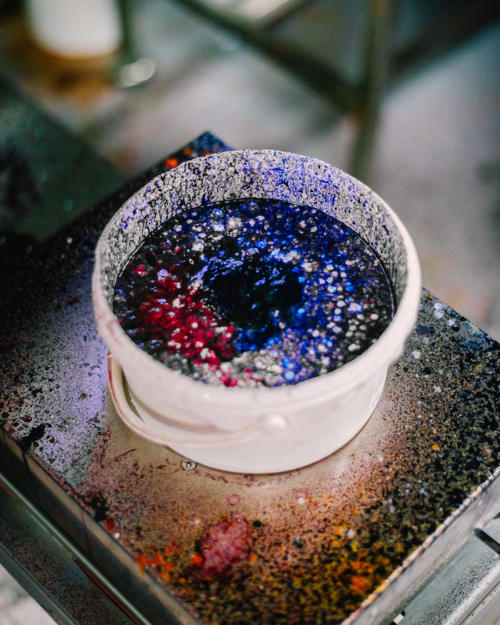
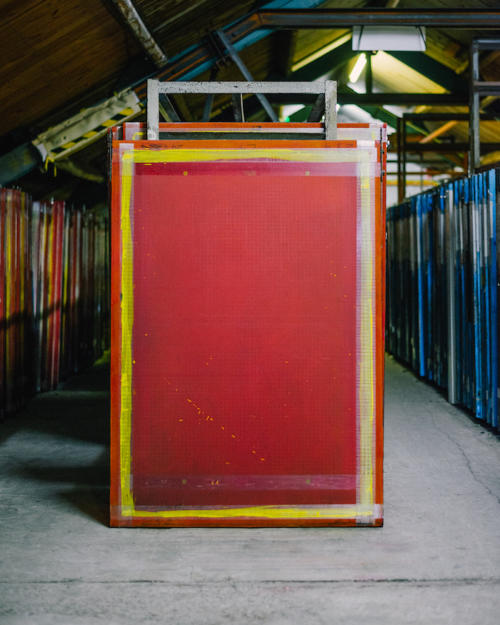
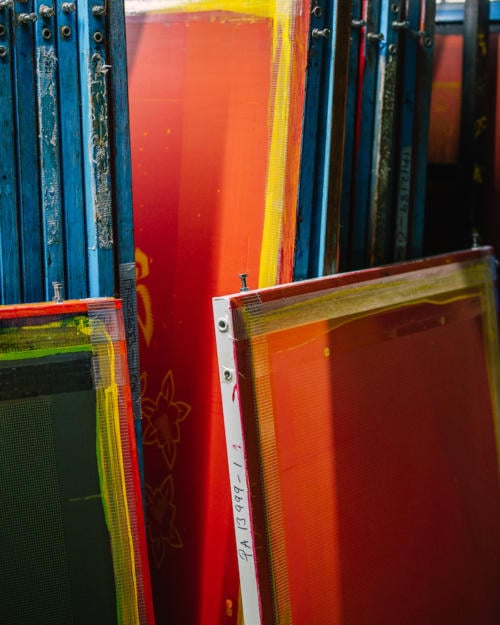
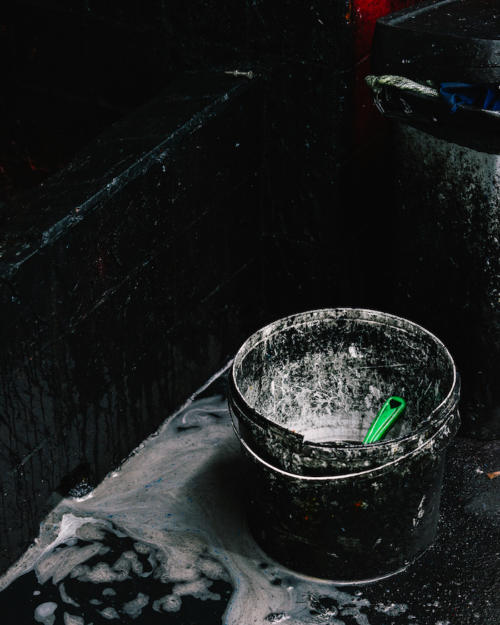
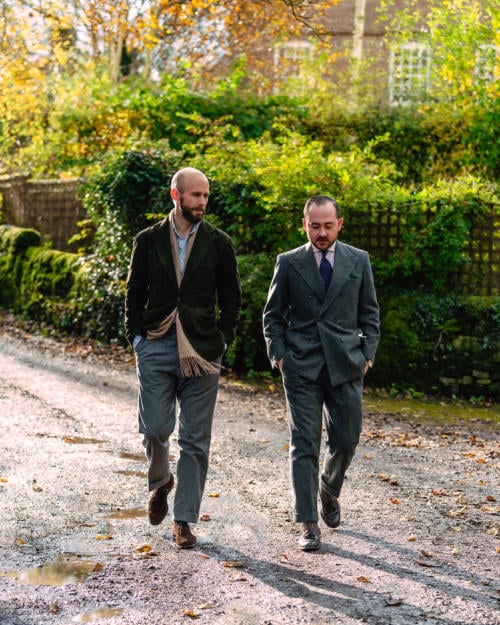


























Simon
Hate to be a critic but I must admit I didn’t really learn anything or gain much insight (apart from that screen printing leads to, arguably, better colour and penetration but isn’t as intricate). Not hugely surprised that Hermes is more sophisticated.
This article is just slightly showing you going to a nice place and taking some nice photos. Not much story, not much learning. It would be great to learn, in this type of article, about the types of inks, how they mix and choose colour, the people that work there, the advantages of these smaller shops, the competitive dynamics of their business, weather or not consumers can visit or have work done, where they sit in the supply chain.
Lots of interesting things to be said, sadly this article didn’t hit them (though you normally manage to get something interesting to say, not critiquing your style in general!)
Not at all, the feedback is always helpful.
It would be impossible to cover more than one or two of those aspects well in a single post, and I concentrated here on the feeling and romance of Adamley.
I can cover more technical aspects elsewhere, and the industry. Though the latter might be a little niche.
No, consumers can not visit and have work done.
Great post. The contrast with your Hermes visit is stark. Your factory visits are some of my favourite articles. More please.
This is fantastic – the place, the writing, the photos. Your writing really conveys what you intend it to – not too many words, but the mental picture it creates is very vivid. Keep it up!
Lovely piece. This is wonderful diffferentiated content, done with the right emphasis and touch.
Couldn’t agree more with the majority of the contributors, reminds me the Ealing comedy ” Man in the White Suit”. Simon, you should’ve worn a white suit to complete the look.
More of these type of articles please.
Best wishes
Phil
Hi Simon
Great article as always.
I was just wondering about the flannels you are wearing, are they A&S bespoke or RTW from the haberdashery?
Bespoke
Hi Simon,
A bit out of left field, but any idea how much it might cost to order a run of printed silk in a reproduction of a vintage pattern on a favorite tie? Do they also do ancient madder silks? I’m sure that the cost is not minute, but it is an interesting and let us say highly stimulating proposition.
Do tell.
I don’t know Evan – the problem would be the minimum you would need to order, if they would take one from an individual. Also Robert Keyte is better known for madders
Hi Simon,
I assumed the minimum, I would be very interested to see what it would be, seeing as ancient madders are typically made in relatively small batches anyway. I am intrigued by this idea. I have a gorgeous ancient madder of my Grandfather’s that I’d like reproduced, and even better if I had enough for several neckties to never run out, and also to have it as a lining for a suit, or two….Hahahaa. My old fixation! Robert Keyte! I will keep that in mind, and enquire!
Thanks again, Simon! 🙂
Dear Evan,
the price per meter is 48€ on 36oz, 100€ set up costs for the screen, 6m minimum which is like 20 ties. They don’t make real madder silk, they do only like a madder finish. Hope that helps.
Best,
Benedikt
The main take away from this is the terrible indictment against British management. Contrasting the high productivity of the French competitor with the low productivity English points in only one direction and one where countless venerable English textile companies have gone before.
@FEIRB1 – You make a fair point about productivity differences between Hermes and Adamley. These appear to be entirely due to technology, rather than to human productivity (ie it’s not that the English workers are lazy or that they insist on taking tea breaks etc).
Hermes is a large company and has had injections of funds from outside shareholders, including LVMH. Therefore, it has money to spend on capital investment, such as the robots and other technology that Simon mentioned. Adamley seems to be a small company and probably doesn’t have the funds to invest in such capital upgrades. If that means that it will fall by the wayside in the future, then that will be very unfortunate.
Of course, it’s worth noting that using robots etc doesn’t necessarily make Hermes any faster at producing fabric for ties and scarves . Perhaps Hermes is faster, perhaps it can produce more square metres of printed fabric per hour than Adamley – we don’t know. What it most likely means, though, is that Hermes employs fewer people to do the same work.
I have to agree with the first poster – it would have been great to learn more about their design archive, for instance, rather than just „the romance of the place“.
On a related note, while I have been very happy with the Shibumi ties, the only printed silk hanky I have from them was rather disappointing. Beautifully designed motif, but the printing quality is not great. Hermes is clearly in a completely different league. So as much as I love small workshops, this seems to be a case of larger, automated factories delivering quality that is far superior
Thanks Jan.
I don’t think it’s accurate that Adamley products are in any way inferior to Hermes – unless you see using fewer colours as necessarily inferior
Jan says the printing quality is not great, Hermes is far superior.
You disagree.
How can you justify that?
Because he is only talking about one type of product from one brand that Adamley makes for. My comment was about Adamley as a whole.
The product might be digitally printed, for example, which would make it a different type of print and not comparable
Sorry, I should have been more precise. I was only referring to this one particular product where the sharpness / clearness of the motif is clearly not up to Hermes standards. Should not have generalized .
It might also have been digitally printed Jan, which would necessarily not be the same as screen printing
Simon, This article is a pleasant diversion and well written. The beginning of the article, where you were wondering if the German gentleman Benedikt may have a skewed view of what is idyllic – is masterful! Kudos to Benedikt’s international flair as he absolutely rocks the British Racing Green.
The majority of your posts are informative and convey valuable information to my wardrobe planning. With this post, I simply laid back and enjoyed the story.
Nice to hear. Thanks Robert
Simon, it’s great that you are going to the source and writing articles like this to highlight aspects of British craftsmanship. Macclesfield has been an important part of the silk trade for over 300 years and before the Huguenots came to Spitalfields. In its heyday there were 70 mills. Now there are two. Let’s celebrate them and remember the history.
Surprised to see that the workers are not wearing gloves…I would think a necessity, considering the environment….
Dear Simon, for better versatility and aging, do you recommend 8 or 9cm tie width? Thanks!
It’s not a big difference Stephan, either should age well. Personally I prefer 9, but I don’t mind 8 as well
Great article. A breeze of fresh air and a good distraction from day to day screen printing technicalities. As a screen printer, I would like to see a part 2, diving more into the technics used to achieve such beautiful prints.